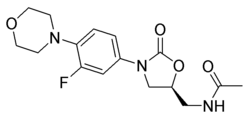The first in a new class of antibacterial drugs to treat serious infections resistant to other antibiotics has been approved by the Food and Drug Administration. Zyvox (linezolid) was approved April 18, less than a month after an FDA advisory committee reviewed study data and recommended its approval.
Zyvox treats infections, including bloodstream infections, associated with vancomycin-resistant Enterococcus faecium (VREF). Vancomycin has long been the drug of last resort in treating infections resistant to other antibiotics. Zyvox also was approved for the treatment of hospital-acquired pneumonia and complicated skin infections, including those due to methicillin-resistant Staphylococcus aureus (MRSA), for community-acquired pneumonia and for uncomplicated skin and skin structure infections.
Infections due to Enterococcus faecium and MRSA are a particular problem in hospital patients and in people with compromised immunity, such as people with AIDS or cancer. The first case of VREF was reported in this country in 1989. Since then, there has been a rapid increase in the incidence of VREF infections, as well as a dramatic rise in the incidence of MRSA infections.
Last fall, FDA approved Synercid, a combination of two older antibiotics, to treat infections resistant to vancomycin. Zyvox, however, is the first in a new class of synthetic drugs--the oxazolidinone class--approved for use in the United States and the world. It is also the first drug in over 40 years to be introduced into the U.S. market for treatment of MRSA infections.
The most frequently reported side effects attributed to Zyvox in clinical studies were headache, nausea, diarrhea, and vomiting. The most important laboratory test change was a decrease in platelet counts.
Zyvox may interact with certain other drugs, including over-the-counter cold remedies that contain pseudoephedrine or phenylpropanolamine, causing an increase in blood pressure. Patients receiving Zyvox should tell their doctors if they are taking such medications.
Therapy with Zyvox is expected to first take place mainly in hospitals or other institutional settings. Doctors have been advised to consider alternatives before prescribing Zyvox to outpatients, due to concerns about inappropriate use of antibiotics leading to an increase in resistant organisms.
Pharmacia and Upjohn, based in Kalamazoo, Mich., developed Zyvox and will market it in the United States.
COPYRIGHT 2000 U.S. Government Printing Office
COPYRIGHT 2004 Gale Group



